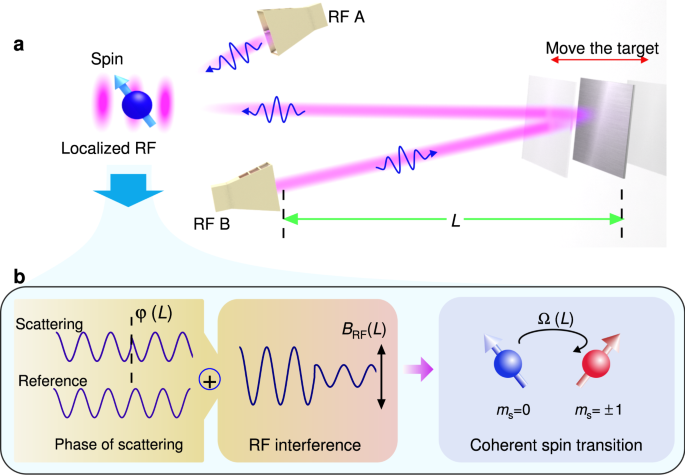Guo Guangcan, an academician of the CAS Member and professor of the University of Science and Technology of China, has made important progress in practical quantum sensing research. The Sun Fangwen research team of Guo Guangcan's team utilizes micro/nano quantum sensing and local enhancement of electromagnetic fields at deep sub wavelengths to study the detection of microwave signals and radio ranging, and achieve positioning with 10-4 wavelength accuracy. On March 9th, relevant research results were published in Nature Communications.
Radar positioning technology based on microwave signal measurement is widely used in autonomous driving, intelligent production, health detection, geological exploration, and other activities. The development of quantum information technology provides new solutions for the development of radar technology. Quantum sensing and precision measurement use quantum coherence, correlation, and other characteristics to enhance the sensitivity of systems to physical quantities, which is expected to exceed the accuracy of traditional measurement methods. Sun Fangwen's research group is oriented towards the practical application of quantum information technology, and is committed to the research of quantum sensing technology in solid-state spin systems. It has developed a charge state depletion nanoimaging method, and achieved ultra diffraction limit resolution electromagnetic field vector sensing and imaging based on diamond nitrogen vacancy color centers [Phys. Rev. Applied 12, 044039 (2019)], Using super resolution quantum sensing, the phenomenon of localized enhancement of electromagnetic fields in the 10-6 wavelength space was explored [Nat. Commun. 12, 6389 (2021)].
This research combines micro nano resolution solid-state system quantum sensing with deep sub wavelength localization of electromagnetic fields to develop high sensitivity microwave detection and high-precision microwave positioning technology. The research team designed a composite microwave antenna composed of diamond spin quantum sensors and metal nanostructures to collect and converge microwave signals propagating in free space into nanospace, thereby measuring microwave signals by detecting localized solid-state quantum probe states. This method converts the detection of weak signals in free space into the detection of the interaction between electromagnetic fields and solid-state spin at a nanoscale, improving the microwave signal measurement sensitivity of solid-state quantum sensors by 3-4 orders of magnitude. In order to further utilize highly sensitive microwave detection to achieve high-precision microwave positioning, the research team has built a microwave interference measurement device based on diamond quantum sensors. Through solid-state spin detection of the interference results of the reflected microwave signal and the reference signal, the phase of the reflected microwave signal from the object and the position information of the object are obtained. At the same time, the research team has achieved quantum enhanced position measurement accuracy to the level of 10 microns (about one tenth of a wavelength) using multiple coherent interactions between solid-state spin quantum probes and microwave photons. The reviewer believes that this work is the first application of diamond quantum sensors in quantum ranging.
Compared with traditional radar systems, this quantum measurement method does not require active devices such as amplifiers at the detection end, reducing the impact of electronic noise and other factors on the measurement limit. Subsequent research will further improve radio positioning accuracy, sampling rate, and other indicators based on solid-state spin quantum sensing, and develop practical solid-state quantum radar positioning technology that exceeds the performance level of existing radars.
The research work has received support from the Ministry of Science and Technology, the National Natural Science Foundation, the Chinese Academy of Sciences, and Anhui Province.
Source: China University of Science and Technology


